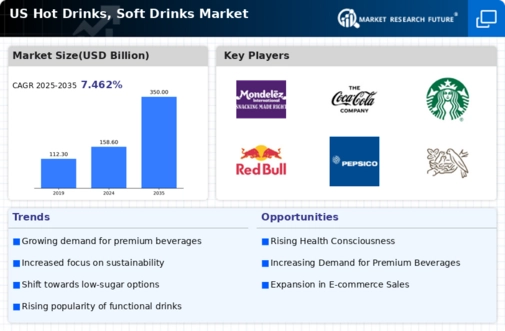Evolving Consumer Preferences
The hot drinks-soft-drinks market is currently experiencing a shift in consumer preferences, with a growing inclination towards beverages that offer unique flavors and health benefits. This trend is particularly evident among younger demographics, who are increasingly seeking out artisanal and craft options. According to recent data, the demand for specialty coffee and herbal teas has surged, with sales growth estimated at 15% annually. This evolving consumer behavior is prompting manufacturers to innovate and diversify their product offerings, thereby enhancing competition within the hot drinks-soft-drinks market. As consumers become more discerning, brands that can effectively cater to these preferences are likely to gain a competitive edge.
Increased Focus on Sustainability
Sustainability is becoming a crucial consideration for consumers in the hot drinks-soft-drinks market. Many brands are now prioritizing eco-friendly packaging and sourcing practices to align with consumer values. A recent survey revealed that 70% of consumers are willing to pay more for products that are sustainably sourced. This shift is prompting companies to adopt greener practices, such as using biodegradable materials and supporting fair trade initiatives. As environmental awareness continues to rise, brands that effectively communicate their sustainability efforts are likely to resonate more with consumers, thereby enhancing their market position within the hot drinks-soft-drinks market.
Health-Conscious Consumption Trends
Health-conscious consumption is a driving force in the hot drinks-soft-drinks market, as consumers increasingly seek beverages that align with their wellness goals. The demand for low-calorie, sugar-free, and functional drinks is on the rise, with sales of herbal teas and wellness shots experiencing notable growth. Recent data indicates that functional beverages, which offer added health benefits, are projected to grow by 12% annually. This trend is prompting manufacturers to reformulate existing products and introduce new offerings that cater to health-conscious consumers. As the focus on health and wellness continues to intensify, brands that can effectively address these needs are likely to thrive in the competitive landscape of the hot drinks-soft-drinks market.
Rise of E-commerce and Online Retail
The rise of e-commerce is significantly impacting the hot drinks-soft-drinks market, as consumers increasingly prefer the convenience of online shopping. Recent statistics indicate that online sales of beverages have grown by 20% over the past year, driven by the pandemic-induced shift towards digital platforms. This trend is prompting traditional retailers to enhance their online presence and adapt to changing consumer behaviors. Furthermore, the availability of subscription services for specialty drinks is gaining traction, providing consumers with curated selections delivered to their doorsteps. As e-commerce continues to expand, it is likely to reshape the distribution landscape of the hot drinks-soft-drinks market.
Technological Advancements in Production
Technological advancements are playing a pivotal role in shaping the hot drinks-soft-drinks market. Innovations in brewing techniques and extraction methods are enabling producers to enhance flavor profiles and improve product quality. For instance, the introduction of cold brew technology has revolutionized the coffee segment, appealing to a broader audience. Additionally, automation in production processes is streamlining operations, reducing costs, and increasing efficiency. This is particularly relevant as the market anticipates a projected growth of 10% in the next five years. As technology continues to evolve, it is expected to further influence consumer choices and operational strategies within the hot drinks-soft-drinks market.
























Leave a Comment